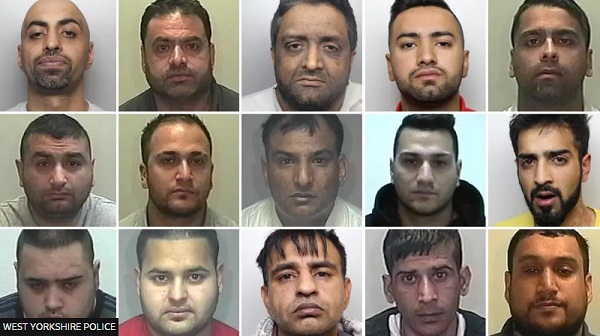Crime
ASIRT Investigation reveals a series of life-threatening incidents police officers overcame to arrest suspects
From the Alberta Serious Incident Response Team (ASIRT)
RCMP officers acted reasonably in shootings
On Oct. 13, 2017, the Alberta Serious Incident Response Team (ASIRT) was directed to investigate the circumstances surrounding two officer-involved shootings that occurred the same day during a continuing event.
The first officer-involved shooting resulted in a minor gunshot wound to a 20-year-old woman. The second officer-involved shooting resulted in serious injuries to a 20-year-old man. Evidence obtained during the investigation included statements from civilian witnesses, EMS personnel, all involved officers and the occupants of the stolen vehicles, as well as radio communications and multiple available video recordings of portions of the events.
On Oct. 13, 2017 at 9:14 a.m., a man called RCMP to report that he had just been involved in a dispute with another man driving a light-coloured Chevrolet truck and when he attempted to confront the driver, the man threatened him with a large knife. There was a female passenger in the truck. When police ran the licence plate provided and contacted the registered owner, it was determined that the truck had been stolen from the Didsbury area earlier that morning.
At 1:30 p.m., the first man and woman picked up a second man in Innisfail who had just been released on bail, having been arrested for possession of a stolen vehicle the day before. They did so in the stolen vehicle seen earlier in the day in Sundre.
At approximately 3:15 p.m., the son of the stolen truck’s owner called RCMP to report that he had spotted the stolen truck in Sundre and was following it. In response, the driver of the stolen truck rammed the son’s car and attempted to run him over when he exited his vehicle. The man threw himself out of the way, but he was struck and sustained minor injury to his leg. The female passenger waved a large knife and threatened to kill the son.
A short time later, officers came across the truck, and unsuccessfully tried to conduct a traffic stop. As officers pulled alongside, the driver could be seen wearing sunglasses and a bandana covering his nose and mouth. The officers terminated the pursuit as both trucks headed west of Sundre but shortly thereafter, they saw the stolen truck driving on a rural road. The driver taunted police as he passed them. Due to concerns for public safety, police did not initiate a pursuit.
The same officers encountered the stolen truck being driven in Caroline but, again, no pursuit was initiated. Shortly thereafter, the officers followed as the truck was driven into a field. The driver turned around and drove back in the direction of the officers who exited their vehicle and drew their service pistols. The truck drove a wide arc around them, so neither officer fired.
At approximately 3:45 p.m., other officers saw the stolen truck travel north on Hwy 22, just west of Caroline, and followed. Police unsuccessfully tried to set up spike belts at two locations but the stolen vehicle avoided them, in one case driving directly at an officer, who had to take evasive action to avoid being struck.
A pursuit was declared shortly after. While followed by two separate police vehicles with emergency lights activated, speeds reached 170-180 km/hr. As the pursuit headed eastbound on TWP Road 400, the woman in the back seat of the stolen truck threw a child’s car seat and other items onto the roadway, creating hazards and attempting to deter the police from continuing their pursuit. The first man was driving and the second man was in the front passenger seat.
As the stolen truck was pursued eastbound onto TWP Road 394, it approached a driveway where an officer had parked his police vehicle and extended a spike belt across both lanes, holding the line in the north ditch. The first man drove the stolen truck left of centre and turned into the north ditch, driving towards the officer. He suddenly pulled back onto the road and the officer ran back beside his police vehicle and drew his pistol. The stolen truck entered the south ditch, drove over the driveway approach past the officer and police vehicle, avoiding the spike belt and returned back to the road, moving eastbound.
Instead of continuing eastbound, the truck swung around to face back towards the officer, his police vehicle and two other officers who had arrived and placed their police vehicles to partially block off any westbound escape. The truck headed directly towards the officer who had earlier placed the spike belt as he stood by his police vehicle. The officer believed that the driver was purposely trying to “run” him over as there was no reason to proceed westbound and engage with police when the eastbound road was unobstructed. At approximately 4:27 p.m., as the truck drove towards the officer, fishtailing and colliding with the police vehicle and coming within feet of the officer, the officer and one other fired their service pistols. A bullet grazed the top of the back of the woman’s head causing a relatively minor laceration.
The truck drove over the spike belt, which destroyed the passenger side tires, leading the truck to flee on its rims at approximately 60-70 km/hr. As an officer tried to set up another spike belt, the truck drove at the officer, who had to retreat to the ditch. At 4:31 p.m., as the truck approached the Hwy 20 intersection, an officer was authorized to force the truck off the road. The officer rammed the side of the truck, forcing it into the north ditch with the police vehicle on one side and a fence on the other. The two men climbed through the passenger window and fled to a nearby field, leaving the injured woman in the back seat.
When the two men came upon a farmhouse, they observed a woman run inside. They approached and kicked in the door to the home where two women were present with children. When they found out the women had no keys to the vehicles on the property, the men took their cellphones so they could not call for assistance, and fled to a second rural residence. They broke into vehicles, obtained a garage door opener to gain access to the residence and obtained keys to a black Ford F250 truck that they then attempted to flee in. The second man was now driving with the first man in the front passenger seat. As they were driving out, an officer driving towards them twice attempted to pin them in on a fence but the stolen truck suddenly reversed and rammed the police truck with enough force to set off the airbags, disabling the police vehicle.
The newly stolen truck was driven through the field and down the 500-metre driveway to access Hwy 20, approaching a point where two officers were placing a spike belt. The truck drove off the roadway into the ditch where one armed officer was. A second armed officer moved forward towards the truck on the south grass shoulder of the driveway. The vehicle suddenly accelerated, re-entered the roadway, swerved aggressively to avoid the spike belt and drove directly towards the second officer. Had he not taken evasive actions, it is beyond dispute that the officer would have been struck by the middle of the front grill of the stolen truck. Available video confirmed that the stolen truck came within what appears to be a matter of 12 to 18 inches of the officer, causing both officers to discharge their service pistols.
Unknown to the officers, the 20-year-old driver sustained two gunshot wounds that left him unable to feel or move his legs. The truck briefly came to a stop in the south ditch, just short of Hwy 20. When the passenger looked through the broken rear window and appeared to reach for something, officers shouted commands to stop. The passenger reached his leg over the center console and “floored” the accelerator, causing the officers to resuming firing.
The truck drove out of the east ditch, crossed Hwy 20 and went into the west ditch where it became immobilized in a grove of trees. Police provided medical care to the injured driver until Emergency Medical Services arrived. Ultimately, the man was airlifted to hospital by STARS air ambulance.
Of the two shots sustained, one shattered the man’s left forearm and the second shot entered his left shoulder shattering bone before becoming lodged in his spine resulting in permanent paralysis.
Having reviewed the comprehensive investigation, Susan Hughson, QC, Executive Director for ASIRT, has determined that there are no reasonable grounds to believe that the officers involved in these events committed any criminal offence(s). As such, no officer will be charged.
Under the Criminal Code, a police officer is authorized to use as much force as is reasonably necessary to perform his or her lawful duties. An officer may only respond with lethal force in circumstances where he or she reasonably believes that there is an imminent risk of death or grievous bodily harm to the officer or any other person. An officer may also use lethal force to prevent flight in limited circumstances.
At the time of this incident, the involved officers were all acting in the lawful execution of their duties. There were more than reasonable grounds to believe that some or all of the occupants of both the first and second stolen trucks had committed indictable criminal offences.
In the entire course of these events, the conduct of the three individuals could objectively demonstrate the danger and significant risk to public. Multiple videos combined with the evidence of both civilian and police witnesses demonstrated that the three occupants of both stolen trucks were reckless, motivated to do whatever was necessary to evade apprehension and, in those circumstances, extremely dangerous. Both men reported that it had not been their intention to hit anyone. However, their conduct, at a minimum, would have created a reasonable apprehension that this was their intent. One person had been threatened and struck, another had been threatened with death, and the stolen vehicles had been driven towards officers in a manner that could easily have been interpreted as an intention to run them down.
Based on the actions of these three individuals, it is only good fortune that no civilian nor police officer was seriously injured or killed. At the time of the first officer-involved shooting, the circumstances created an objectively reasonable belief that there was an imminent risk of grievous bodily harm or death and, as such, officers were entitled to use lethal force. At the time of the second officer-involved shooting, once again, the circumstances created an objectively reasonable belief that there was an imminent risk of grievous bodily harm or death and both officers were entitled to use lethal force to address that threat.
Although the injury is believed to have occurred by the time of the attempted flight with the assistance of the passenger, based on all the evidence, it was subjectively and objectively reasonable to resort to lethal force to prevent further flight. The force used was necessary for the purpose of protecting the officer or any other person from imminent or future death or grievous bodily harm. Both men had repeatedly demonstrated a willingness, over a very limited period of time, to risk causing death or grievous bodily harm to both civilians and officers to further their flight and evade apprehension, and had engaged in a protracted crime spree doing so. The risk was not hypothetical. The threat was relatively immediate. In their multiple encounters that day, they had threatened and/or endangered life. If anything, their conduct had been escalating. The rapid forward movement of the vehicle was reasonably inferred to be an attempt at continued flight and the vehicle had a clear path forward. The only means at their disposal in that moment was the use of lethal force. Given the demonstrated conduct of both men, they needed to be stopped before they seriously injured or killed someone. The fact that they had not done so to that point was the result of good luck, nothing more. It was reasonable to act in the circumstances.
ASIRT’s mandate is to effectively, independently, and objectively investigate incidents involving Alberta’s police that have resulted in serious injury or death to any person. This mandate includes incidents involving discharge of a firearm that would likely have resulted in serious injury or death had the person been struck.
Crime
UK finally admits clear evidence linking Pakistanis and child grooming gangs

Quick Hit:
After years of denial and political cover-ups, the UK government has formally acknowledged a disturbing link between Pakistani-heritage men and child grooming gangs. A scathing new review has prompted Prime Minister Keir Starmer to reverse course and launch a full national inquiry into the widespread abuse.
Key Details:
- The Casey Review found “clear evidence” of Pakistani men’s overrepresentation in grooming gangs and accused authorities of ignoring the abuse to avoid accusations of racism.
- Home Secretary Yvette Cooper confirmed over 800 historic child sex abuse cases will be reopened and prosecuted where possible.
- The Labour Party and Prime Minister Starmer were previously opposed to a national inquiry, with critics calling this reversal a politically motivated “smokescreen.”
Diving Deeper:
The British government has finally acknowledged a link between Pakistani-heritage men and the grooming gang epidemic that has plagued communities across England for decades. The admission comes following the release of a damning public review led by Baroness Louise Casey, which uncovered years of institutional failure, racial sensitivity, and political cowardice.
Home Secretary Yvette Cooper presented the findings in Parliament, confirming that the Casey Review had “identified clear evidence of over-representation among suspects of Asian and Pakistani-heritage men.” She condemned the systematic rape of vulnerable girls—some as young as 10—and the authorities’ “unforgivable” failure to act.
“The sexual exploitation of children by grooming gangs is one of the most horrific crimes,” Cooper said, noting that too many warnings had been ignored over the last 15 years. She announced that the government would adopt all of Baroness Casey’s recommendations and reopen more than 800 historic cases.
Prime Minister Keir Starmer, who previously dismissed calls for a national inquiry as “far-right misinformation,” abruptly changed course over the weekend and agreed to a full inquiry with legal authority to compel testimony. This reversal followed mounting pressure from campaigners like Dame Jasvinder Sanghera, Elon Musk, and Reform UK’s Nigel Farage.
Labour MP Sarah Champion, once ousted for raising alarms about Pakistani grooming gangs in her Rotherham constituency, welcomed the inquiry. “There’s a real sense justice has not been handed out fairly,” she said, accusing officials of failing victims for fear of “causing offense.”
The Casey review also pointed to illegal immigration as a contributing factor and called for mandatory ethnicity data collection in child exploitation cases. Critics argue that authorities in Labour-run areas turned a blind eye to the abuse—some allegedly in exchange for votes—treating white working-class girls as expendable while shielding perpetrators.
Former detective and grooming whistleblower Maggie Oliver expressed skepticism, warning that unless the inquiry is led by Baroness Casey, it risks becoming another whitewash. “This is about gross criminal neglect at the top of policing, at the top of government, at the top of social services,” Oliver said.
While the inquiry marks a long-overdue step toward accountability, some warn it may be politically perilous for Starmer. As former head of the Crown Prosecution Service, he held a central role when many of these abuses first surfaced. And with many of the cover-ups tied to Labour councils, the fallout could deepen public distrust in the party.
Crime
Minnesota shooter arrested after 48-hour manhunt

 MxM News
MxM News
Quick Hit:
Vance Luther Boelter, accused of killing former Minnesota State House Speaker Melissa Hortman and her husband, was captured Sunday after leading law enforcement on a 48-hour manhunt.
Key Details:
-
Boelter allegedly began his rampage around 2 a.m. Saturday at Sen. Hoffman’s Champlin home, shooting both the senator and his wife, Yvette. The couple survived after emergency surgery.
-
He then traveled to Rep. Melissa Hortman’s Brooklyn Park home, where she was pronounced dead at the scene and her husband died shortly afterward at a hospital.
-
The suspect reportedly sent a farewell message to friends before fleeing and was later arrested in a Sibley County field Sunday night.
Sources provided this photo of Boelter from the scene after his arrest. pic.twitter.com/q4F9uPkm53
— Liz Collin (@lizcollin) June 16, 2025
Diving Deeper:
Vance Luther Boelter, the man accused of carrying out a targeted shooting of Democrat lawmakers in Minnesota, was taken into custody Sunday night following a 48-hour manhunt that spanned multiple counties. According to a report from Alpha News, Boelter was arrested in a field in rural Sibley County after evading police for more than a day following the deadly shootings.
Boelter, 57, previously served as an appointee under Gov. Tim Walz and is accused of murdering former Minnesota House Speaker Melissa Hortman and injuring State Senator John Hoffman and his wife, Yvette. Authorities say Boelter disguised himself as a police officer—complete with a uniform, ballistic vest, and Halloween mask—before launching the coordinated attacks early Saturday morning.
The violence began just after 2 a.m. when Boelter allegedly entered the Hoffman residence in Champlin and opened fire. Both the senator and his wife were struck multiple times. Their daughter, Hope, was reportedly shielded from the gunfire by her mother. The couple’s nephew confirmed that both John and Yvette Hoffman underwent surgery and were listed in stable condition by Sunday.
From there, Boelter allegedly drove to Brooklyn Park and carried out a second attack at the home of Speaker Emerita Hortman. The 55-year-old lawmaker was found dead inside the home, while her husband was transported to a hospital where he later succumbed to his injuries.
Brooklyn Park police officers, alerted by the earlier incident, arrived as Boelter was leaving the Hortman residence. A standoff ensued, with officers briefly cornering the suspect inside the house and opening fire, though Boelter managed to flee.
Boelter reportedly sent a chilling text message to close friends. “David and Ron, I love you guys. I made some choices, and you guys don’t know anything about this, but I’m going to be gone for a while,” he wrote. “May be dead shortly, so I just want to let you know I love you guys both and I wish it hadn’t gone this way.”
-

 Alberta2 days ago
Alberta2 days agoCentral Alberta MP resigns to give Conservative leader Pierre Poilievre a chance to regain a seat in Parliament
-

 Daily Caller2 days ago
Daily Caller2 days ago‘Not Held Hostage Anymore’: Economist Explains How America Benefits If Trump Gets Oil And Gas Expansion
-

 Alberta2 days ago
Alberta2 days agoCalls for a new pipeline to the coast are only getting louder
-

 Business2 days ago
Business2 days agoCanada’s economic pain could be a blessing in disguise
-

 Alberta2 days ago
Alberta2 days agoAlberta pro-life group says health officials admit many babies are left to die after failed abortions
-

 Censorship Industrial Complex1 day ago
Censorship Industrial Complex1 day agoJordan Peterson reveals DEI ‘expert’ serving as his ‘re-education coach’ for opposing LGBT agenda
-

 Alberta1 day ago
Alberta1 day agoUnified message for Ottawa: Premier Danielle Smith and Premier Scott Moe call for change to federal policies
-

 Economy1 day ago
Economy1 day agoOttawa’s muddy energy policy leaves more questions than answers






